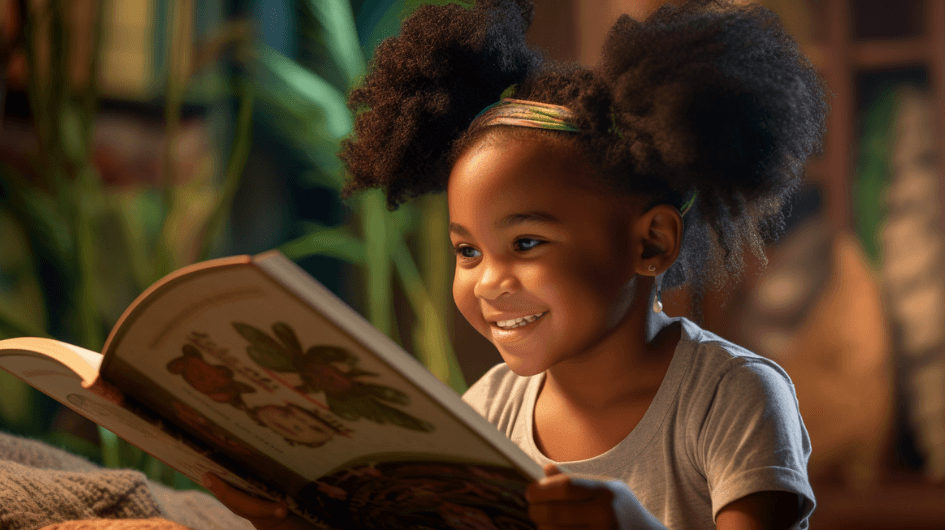
How to Choose the Right Books for Your Child
Choose the right books for your child and foster a love for reading that can have a profound impact on their development, imagination, and lifelong learning.

Children’s picture books hold a special place in the hearts of both young readers and adults. Picture books are entertaining and essential for a child’s development. They offer a unique blend of visual and textual elements that stimulate the imagination, promote language development, and foster emotional and cognitive growth.
Discover the magic of children’s picture books and recognize their significance in shaping young minds, fostering empathy, and cultivating a lifelong love for reading. Prepare to be enchanted as we explore the wonders hidden within the pages of picture books.
Children’s picture books are unique in their ability to blend words with captivating illustrations, creating a powerful visual storytelling experience. The visual component of picture books goes beyond mere decoration—it plays a vital role in engaging young readers, stimulating their imagination, and facilitating their understanding of the narrative.
The illustrations in picture books provide visual cues that help children understand the story, follow the sequence of events, and make connections between the text and the images.
The vivid colors, expressive characters, and detailed settings in picture books stimulate the senses, making the reading experience more immersive and memorable.
Picture books often rely on visual narratives, where the illustrations alone can convey emotions, actions, and story elements, enabling pre-readers and emergent readers to engage with the story independently.
By examining the illustrations, children learn to interpret visual information, make inferences, and infer meaning beyond the written words.
Picture books encourage children to observe details, analyze visual elements, and develop a discerning eye for artistic techniques, such as composition, color palettes, and perspective.
The interplay between text and illustrations in picture books helps children understand the concept of visual communication, as they recognize how images can convey meaning and enhance the written narrative.
The imaginative illustrations in picture books transport young readers to different worlds, spark their creativity, and encourage them to visualize the story in their minds.
Exposure to visual storytelling in picture books inspires children to create their own stories, drawings, and artwork, fostering their imaginative and artistic abilities.
Visual metaphors and symbolic imagery in picture books introduce children to abstract concepts, encouraging them to think metaphorically and make connections between the symbols and the story’s underlying themes.
The power of visuals in children’s picture books cannot be overstated. The marriage of words and illustrations creates a multidimensional reading experience that engages the senses, promotes visual literacy skills, and fuels the imagination. As we continue our exploration of children’s picture books, we will discover how these captivating visuals intertwine with the written narrative to evoke emotions, convey meaning, and leave a lasting impression on young readers.
Children’s picture books can address and nurture emotional development in young readers. Through relatable characters, thoughtfully crafted narratives, and evocative illustrations, picture books provide a safe space for children to explore and understand their emotions and those of others.
Picture books feature diverse characters facing a range of emotions and situations, allowing children to see themselves in the story and develop a sense of empathy.
The vivid illustrations and carefully chosen words in picture books evoke emotions in young readers, enabling them to empathize with the character’s experiences and emotions.
As children immerse themselves in picture book narratives, they gain opportunities to see the world from different perspectives, enhancing their understanding of others and promoting empathy.
Picture books help children expand their emotional vocabulary by introducing them to different feelings and providing language to express and label emotions.
Picture books address various emotions, including fear, sadness, anger, and loneliness, offering young readers strategies and coping mechanisms to navigate these complex feelings.
Picture books often explore life experiences such as starting school, making friends, dealing with loss, and adapting to change, providing comfort and reassurance to children facing similar situations.
Through the interactions and emotional journeys of picture book characters, children develop the ability to recognize and understand the emotions of others, fostering social intelligence.
Picture books often present characters facing conflicts and dilemmas, teaching children valuable lessons for problem-solving, empathy, and cooperation.
Picture books model healthy emotional responses and provide examples of self-regulation techniques, empowering children to manage their own emotions effectively.
Engaging with picture books, children learn to navigate their emotions, develop empathy and understanding of others, and build a strong foundation for social-emotional intelligence. As we continue, we will discover how these emotional connections pave the way for meaningful discussions, personal growth, and the development of valuable life skills.
Children’s picture books offer more than just entertaining stories and beautiful illustrations; they also provide numerous cognitive benefits that support children’s overall cognitive development.
Picture books expose children to a wide range of vocabulary and help them develop a rich and diverse linguistic repertoire.
The engaging narratives in picture books enhance children’s comprehension skills as they follow the story, infer meaning from the illustrations, and make connections between the text and visuals.
Exposure to story structures and plot development help children understand narrative elements, such as character development, setting, and sequencing of events.
Picture books encourage children to actively engage with the story by asking questions, making predictions, and reflecting on the events, promoting critical thinking and problem-solving skills.
Following the storyline in picture books helps children understand the concept of sequencing and recognize cause-and-effect relationships between events.
Picture books often introduce imaginative and fantastical elements, fostering cognitive flexibility as children navigate between reality and fiction, expanding their creative thinking abilities.
The text and illustrations in picture books promote visual literacy skills, enabling children to interpret and analyze visual information.
Engaging with picture books encourages children to retell and create their own stories, enhancing their narrative and storytelling skills.
The memorable characters, settings, and events in picture books support memory development and recall abilities as children remember and discuss the story elements.
Through engaging narratives, colorful illustrations, and interactive elements, picture books provide a wealth of cognitive benefits to young readers. As children actively engage with these books, they develop language skills, critical thinking abilities, and comprehension strategies that lay the foundation for lifelong learning and intellectual growth.
Children’s picture books have a significant role in promoting cultural diversity, representation, and inclusivity. Books serve as windows into different cultures, experiences, and perspectives, helping children develop a deeper understanding and appreciation for the world around them.
Picture books featuring diverse characters and settings expose children to different cultures, traditions, and ways of life, expanding their worldview and fostering cultural understanding.
Representation in picture books challenges stereotypes by depicting characters from various backgrounds and showcasing their unique strengths, abilities, and contributions.
When children encounter characters from diverse backgrounds in picture books, they develop empathy and establish connections, helping to realize that despite our differences, we share common emotions and experiences.
Picture books featuring characters from underrepresented groups provide a sense of belonging and affirmation for children who may not often see themselves represented in mainstream media.
Characters with similar backgrounds, experiences, or identities can positively impact children’s self-perception, self-acceptance, and self-esteem.
Exposure to diverse characters and cultures in picture books helps children develop cultural competence, respect for differences, and a celebration of diversity.
Picture books with diverse characters and themes provide opportunities for parents and children to engage in meaningful discussions about culture, identity, and social issues.
Picture books that address social justice issues and inequality empower children to recognize and challenge injustice, cultivating a sense of fairness and the desire for positive change.
Picture books shape children’s perceptions, attitudes, and values from a young age. By featuring diverse characters, cultures, and experiences, these books create a more inclusive and empathetic world for young readers.
Children’s picture books hold immense educational value. They are powerful tools for early learning and development, intellectual growth, and academic success.
Picture books expose children to a rich and diverse range of words, helping to expand their vocabulary and language skills.
The rhythmic and rhyming text found in picture books promotes phonological awareness, helping to recognize and manipulate sounds in words.
Engaging with picture books introduces children to print concepts, such as left-to-right directionality, word recognition, and story structure, preparing them for reading.
Some picture books incorporate counting, shapes, patterns, and basic math concepts, introducing young readers to foundational numeracy skills.
Picture books can expose children to scientific concepts, nature, and the world around them, fostering curiosity and a love for exploration.
Engaging with picture books, children develop foundational skills and knowledge across various domains, including language, cognition, social-emotional learning, and creativity. Picture books foster a love for reading, provide learning opportunities, and create a solid educational foundation that supports children’s lifelong learning journey.
Picture books are often associated with early childhood and the formative years of learning to read. However, their value extends far beyond those early stages.
Picture books create a strong foundation for a lifelong love of reading, instilling the joy and pleasure of engaging with stories and literature.
Even as children become independent readers, picture books can still captivate and inspire, encouraging them to revisit cherished titles and discover new stories.
Revisiting beloved picture books from childhood can evoke nostalgia, bring back cherished memories, and create connection and comfort.
Picture books have the potential for intergenerational connection. Adults can pass their favorite titles to children, creating shared experiences and bonding moments.
Picture books transcend age boundaries and continue to be meaningful experiences throughout one’s life. As we appreciate the enduring value of picture books, we recognize their role in shaping not only childhood but also the lives of readers as they grow, evolve, and continue to find inspiration within their pages.
Picture books hold a special place in the hearts and minds of children and adults. From the early developmental stages to adulthood, picture books provide a powerful tool for learning, imagination, empathy, and connection.
These colorful and engaging books influence children’s language skills, cognitive abilities, social awareness, and creative thinking. They act as portals to diverse cultures, offering unique perspectives and fostering inclusivity.
As parents, we must recognize the value of picture books and how they shape the minds and hearts of young readers. Providing access to a diverse range of picture books, we foster curiosity, imagination, and a love for learning that can last a lifetime.

Choose the right books for your child and foster a love for reading that can have a profound impact on their development, imagination, and lifelong learning.

Getting your child excited about reading opens up a world of imagination, knowledge, and personal growth, and becomes a cherished lifelong companion.

Mindful reading offers a unique opportunity to foster mindfulness, connect with your child, and nurture a lifelong love for reading.

From the early developmental stages to adulthood, picture books provide a powerful tool for learning, imagination, empathy, and connection.

By engaging children in reading and fostering meaningful discussions, parents can help children develop a strong foundation of empathy and compassion.
